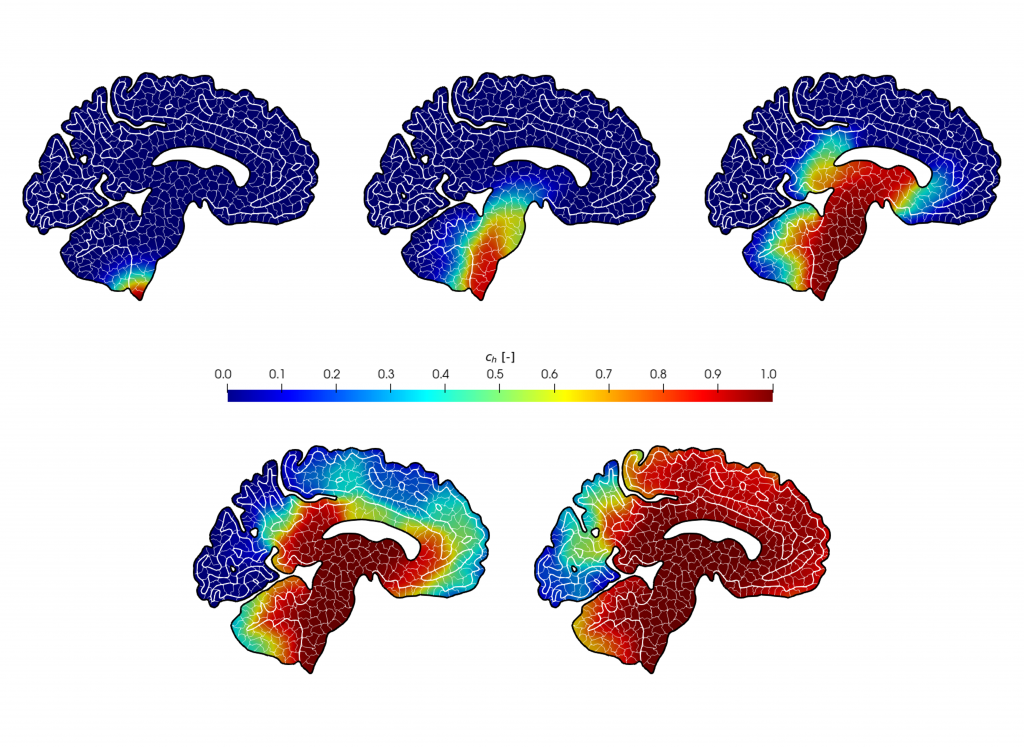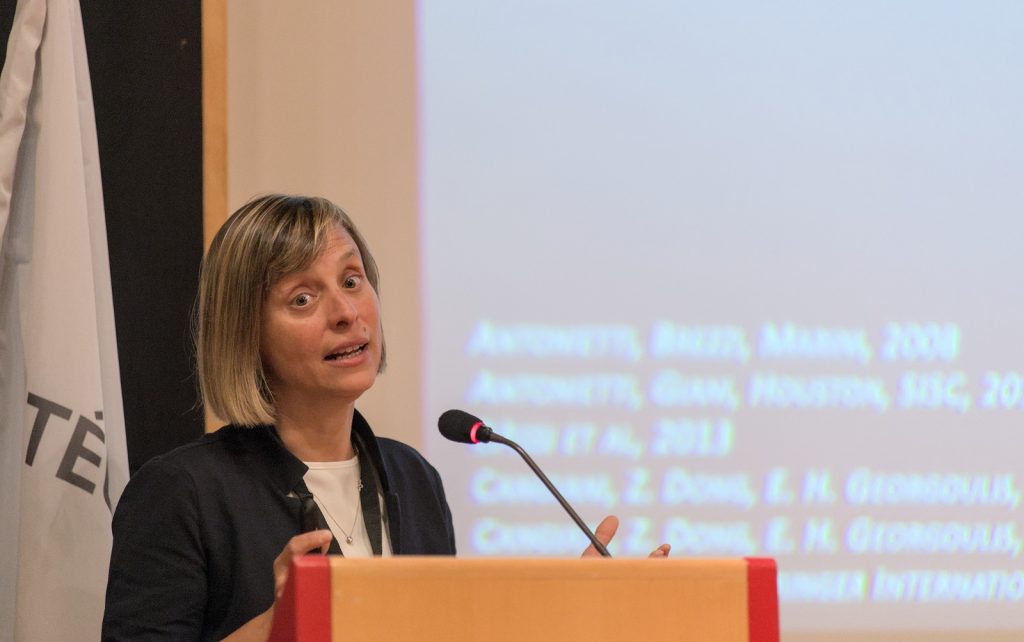Professor Paola Antonietti, the principal investigator in the team awarded the Synergy Grant of the ERC — ERC – European Research Council, leads the Laboratory for Modelling and Scientific Computation (MOX) at the Department of Mathematics at Politecnico di Milano. This grant provides a funding of €7.8 million for a period of six years.
Numbers fascinated Antonietti from a very early age, so much so that she cannot remember exactly when she began to take an interest in them. “My fascination developed very organically. As a child, I showed an interest in logic and construction games like Lego and Meccano, which I used to take apart and put back together. As a young girl, I continued to do the same thing with the computer: I remember whole afternoons spent on the Commodore 64, trying to learn its secrets. That's how, little by little, I got into what I still love today: solving problems, finding patterns, categorising, abstracting”. sThe 43-year-old from Milan could not have imagined that this passion would not only lead to her graduate in Mathematics with a distinction, but also secure her a scholarship for a PhD in Mathematics and Statistics at the University of Pavia, then to become a researcher at the School of Mathematical Sciences at the University of Nottingham and, finally, to embark on a career at Politecnico di Milano. After years of research and teaching, she has been Full Professor of Numerical Analysis at Politecnico di Milano since 2019 and Head of the Laboratory for Modeling and Scientific Computing (MOX) at the Department of Mathematics since 2023. “And to think that after secondary school I wanted to study medicine! But my family and my maths and physics teacher pushed me to pursue my talent in mathematics. Aside from the subject, the most important factor for me was my love for studying itself, so I made sure to study all my life. I never lose heart: if something doesn't work out for me, I don't give up; the more complicated an issue is, the more I feel motivated to work hard to find a solution. And this, in a competitive field such as academia, has made all the difference”.
Oggi i risultati si vedono, e non sono solo tappe di crescita professionale individuale elencate in un curriculum. Con Nemesis (acronimo di NEw GEneration MEthods for Numerical SImulationS), progetto di ricerca internazionale che la vede al fianco di Lourenço Beirão da Veiga (Università degli Studi di Milano-Bicocca), Daniele Di Pietro (Université de Montpellier) e Jérôme Droniou Jérôme Droniou (direttore di ricerca del CNRS – Centre National de la Recherche Scientifique), Antonietti è impegnata nello sviluppo di metodi numerici di nuova generazione, metodi creati a partire da basi teoriche e messi in pratica attraverso l’uso di supercomputer, allo scopo di risolvere le sfide globali e tecnologiche del XXI secolo, principalmente nel campo della sostenibilità. Di recente il team ha ottenuto un riconoscimento importante: il gruppo di lavoro si è aggiudicato uno dei 37 Synergy Grant dell’ERC.
“The Nemesis project is a large European project funded to improve numerical simulation techniques for complex phenomena," she explains. "When we want to model physical phenomena, such as those in engineering or science, we use mathematical equations. However, these equations are often too complex to solve directly, and this is where numerical methods step in to approximate the solutions using computers. Therefore, our ambition is to develop better, more precise and efficient methods than the ones that already exist, in order to work out approximations of complex phenomena and implement them on computers with extremely high computing power. To this end, we resort to more flexible calculation grids, called “polytopals”, which differ from the standard elements, i.e. those common and regular geometric shapes — cubes, prisms, tetrahedrons, hexahedrons, etc — commonly used to simplify the representation of a calculation domain. They are different in that they can freely adapt to the edges or geometries of the real phenomena being simulated”. Obviously, this may sound abstruse to anyone who is not a mathematician, but in fact it is the same as if you were to represent a landscape: according to traditional methods, you could use small squares or triangles to depict the ground, the sky, the trees, but if the landscape is particularly irregular or has peculiarities, those rigid geometric figures may be limiting and, for a more accurate representation, it would be better to resort to pieces of flexible cardboard modelled ad hoc”.
“We are currently experiencing a period of significant changes, which are happening right before our eyes at an unprecedented speed,” Antonietti observes. “In this context, the universal language of mathematics, i.e. the ability to describe quantitative phenomena through equations, is fundamental. This is because the same mathematical equations can be used to study either how blood circulates in the brain or how a pollutant spreads in water; it is only the values of the physical and geometrical parameters that change, and this allows us to perform virtual simulations to obtain detailed and quantitative answers to problems of various kinds. For example, we might want to assess the effects of a potential earthquake, predict the risk of heart problems after an arrhythmia, optimise the shape and resistance of tyres, and personalise radiotherapy treatments for patients with cancer”.
È quanto fanno i ricercatori di MOX, le cui simulazioni virtuali e analisi dei dati fungono da «laboratori digitali che permettono di esplorare e quantificare una vasta gamma di fenomeni», per dirla con Antonietti, ispirata in questo dal professore di fama mondiale Alfio Quarteroni, il matematico padre fondatore del MOX, alla guida dello stesso dal 2002 al 2022. «Gli devo molto, è grazie alla sua innovativa visione che ho assimilato un modo di fare matematica al servizio delle sfide concrete e realizzato quanto conti, in tutto ciò, confrontarsi costantemente con i colleghi di altre discipline, dagli ingegneri ai designer, dagli architetti agli scienziati applicati. All’inizio non è stato tutto rose e fiori, avevo alle spalle un percorso diverso, per cui i primi anni al Politecnico non sono stati facili. Ma all’Università di Pavia avevo avuto maestri eccezionali: penso alle mie direttrici di tesi di dottorato, le professoresse Annalisa Buffa, ora all’École Polytechnique Fédérale di Losanna (EPFL), e Ilaria Perugia, attualmente all’Università di Vienna, così come a Franco Brezzi e a Donatella Marini. Questo mi ha aiutata e oggi sono fiera di essere parte di una realtà così prestigiosa: secondo l’ultimo QS World University Rankings, il Dipartimento di Matematica del Politecnico di Milano si classifica primo in Italia, 11esimo in Europa e 34esimo nel mondo, tra i competitor nella stessa materia».
In the meantime, the MOX has also grown: in the year of its foundation it had about ten researchers, today we have about a hundred. The focus is on problem-driven research of a trans- and inter-disciplinary nature, aimed at application in the most diverse fields, from neuroscience to ecology, from manufacturing processes to sustainable mobility and digitalisation. “In the same vein, Nemesis aspires to develop a new generation of numerical methods by overcoming current obstacles, including by perfecting predictive capabilities with artificial intelligence techniques. At the heart of this research are the aforementioned polytopic methods, which, by supporting computational grids made up of elements of any shape and thus abandoning the classical approach, enable both an exceptional approximation capacity of the data and the domain or field of application, as well as the direct integration of specific physical laws in the numerical domain — integration that enables the actual structure of the physical problem under investigation to be reflected — and maximise computational processing”.
The main goal is to develop a rigorous mathematical framework and efficient algorithms to enable and facilitate this new way of doing simulations that will ultimately determine policy strategies across various sectors. “In particular, as the Nemesis team, we will mitigate the effects of anthropogenic activities in the subsurface, for example by building virtual simulations to predict the effects of CO2 storage activities or geothermal energy production. And predict the equations of magnetohydrodynamics or MHD, i.e. the mathematical instructions that tell us how electrically conducting liquids behave in the presence of a magnetic field, used to study the complex mechanisms of nuclear fusion, space meteorology and much more. The MHD equations play a key role in computer modelling of aluminium production processes, which are energy-intensive and therefore need to be optimised with respect to the environment”.
At the time of her graduation there was still little talk of the gender gap in STEM disciplines (Science, Technology, Engineering and Mathematics), a topic that is now at the centre of public debate and has long been a priority for Politecnico, where women make up less than 30% of the 47,000 students and 1,400 researchers. “There is still a long way to go, but things are changing," Antonietti comments. “Real-life actions have been introduced in this sense: orientation activities aimed at female high school students towards STEM subjects, scholarships for female students who choose to enrol in engineering courses with a lower presence of women, nurseries and summer camps for the university community, among many others. As a mother of two daughters aged 6 and 11, I can testify that these measures can make a difference: actions speak louder than words and I believe it is essential to show girls and young women with real-life examples that 'it can be done'. This is also true for me in my private life: in my family there is no separation of roles”. Regarding her professional career, Antonietti states that she has “never felt the burden of being a woman, not even in situations where she was the only woman at the table — something that has frequently happened and still happens for many women”. But she emphasises that “over the years, she has experienced the impact of horizontal segregation — women in STEM subjects are under-represented — and vertical segregation, linked to gender inequality in senior roles”. She continues: “A cultural change is needed. In this respect, the European Commission, through the inclusion of the issue of gender in all development policies, makes a real impact: the signs of progress are beginning to be seen a little everywhere, and it is no coincidence that Politecnico is now led, for the first time since its foundation, by a female dean”.
From any perspective, winning an ERC Synergy Grant is an achievement to be celebrated: this year, out of 395 projects that took part in the call, only 37 (five of which were participated in by Italian scientists) were awarded funding. 135 researchers were called upon to execute them at 114 universities and research centres in 19 European countries and elsewhere. “ERC's line of research funding is undoubtedly the most prestigious in Europe,” says Antonietti. “I am proud of this milestone achieved with Nemesis, not least because proposals in every field of science are evaluated, without predefined topics and assessed on the sole criterion of scientific excellence”. And casting her mind back to when, as a child, she enjoyed assembling Lego bricks, she adds: 'I am not obsessed with mathematics, I also like reading, in fact, I burn through books. And there is one book that means a lot to me, “Cuore” by Edmondo De Amicis. It was given to me at primary school by my teacher, as a reward for being a good reader, and it has been with me during the most important moments of my life: when I left home, when I got married, when I passed it on to my daughters. Because it is a tribute to education, to respect, to kindness, to gratitude, to courage, to sacrifice, and it is from education and culture that the indispensable values of protecting and defending everyone’s rights arise”.



